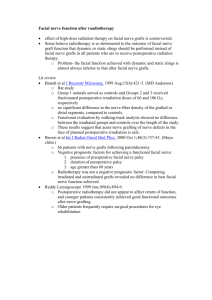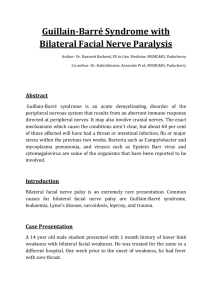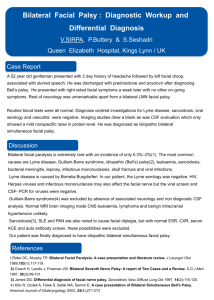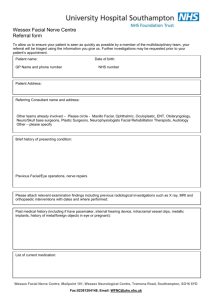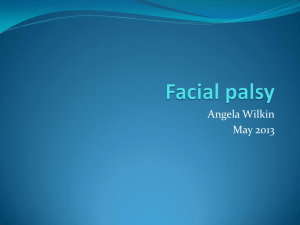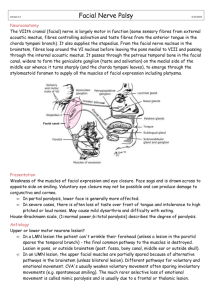Post-traumatic acute bilateral facial nerve palsy
advertisement
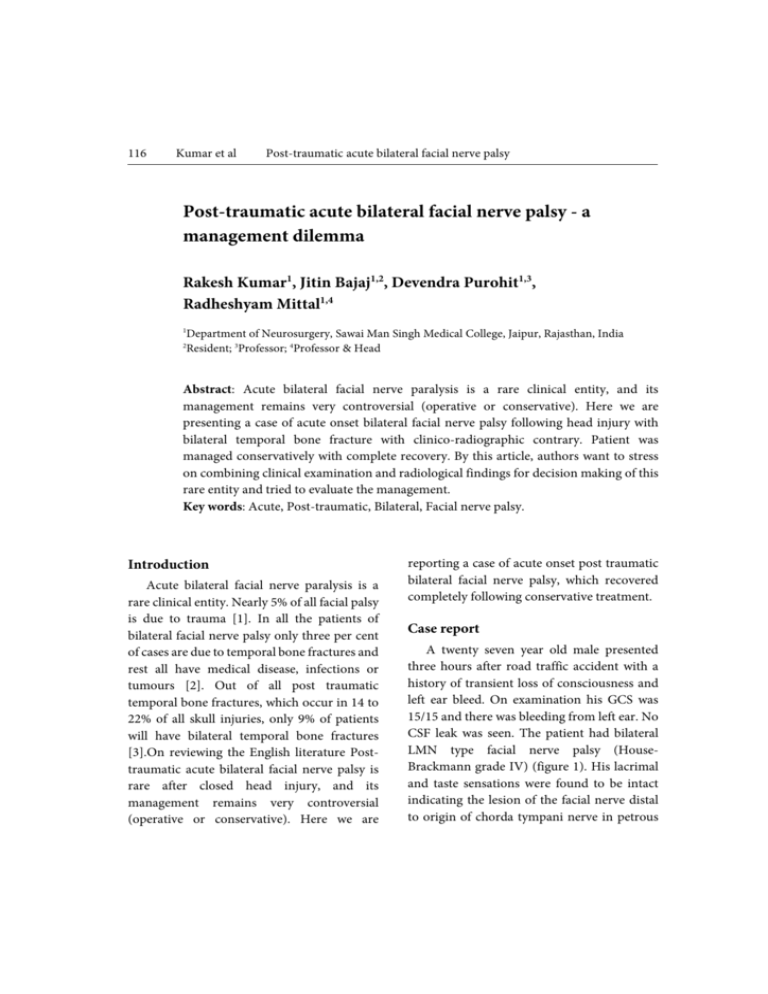
116 Kumar et al Post-traumatic acute bilateral facial nerve palsy Post-traumatic acute bilateral facial nerve palsy - a management dilemma Rakesh Kumar1, Jitin Bajaj1,2, Devendra Purohit1,3, Radheshyam Mittal1,4 1 Department of Neurosurgery, Sawai Man Singh Medical College, Jaipur, Rajasthan, India Resident; 3Professor; 4Professor & Head 2 Abstract: Acute bilateral facial nerve paralysis is a rare clinical entity, and its management remains very controversial (operative or conservative). Here we are presenting a case of acute onset bilateral facial nerve palsy following head injury with bilateral temporal bone fracture with clinico-radiographic contrary. Patient was managed conservatively with complete recovery. By this article, authors want to stress on combining clinical examination and radiological findings for decision making of this rare entity and tried to evaluate the management. Key words: Acute, Post-traumatic, Bilateral, Facial nerve palsy. Introduction Acute bilateral facial nerve paralysis is a rare clinical entity. Nearly 5% of all facial palsy is due to trauma [1]. In all the patients of bilateral facial nerve palsy only three per cent of cases are due to temporal bone fractures and rest all have medical disease, infections or tumours [2]. Out of all post traumatic temporal bone fractures, which occur in 14 to 22% of all skull injuries, only 9% of patients will have bilateral temporal bone fractures [3].On reviewing the English literature Posttraumatic acute bilateral facial nerve palsy is rare after closed head injury, and its management remains very controversial (operative or conservative). Here we are reporting a case of acute onset post traumatic bilateral facial nerve palsy, which recovered completely following conservative treatment. Case report A twenty seven year old male presented three hours after road traffic accident with a history of transient loss of consciousness and left ear bleed. On examination his GCS was 15/15 and there was bleeding from left ear. No CSF leak was seen. The patient had bilateral LMN type facial nerve palsy (HouseBrackmann grade IV) (figure 1). His lacrimal and taste sensations were found to be intact indicating the lesion of the facial nerve distal to origin of chorda tympani nerve in petrous Romanian Neurosurgery (2015) XXIX (XXII) 1: 116 - 119 bone. All other cranial nerves were normal. Audiometric examination, showed no conductive/ sensorineural hearing loss. His CT scan of head (figure 2) revealed right temporal contusion without any mass effect. CT right temporal bone (figure3b) was suggestive of longitudinal fracture of squamous & petrous part involving anterior margin of middle ear cavity reaching up to lateral margin of meatal segment of facial nerve canal, and longitudinal fracture of squamous & petrous part of left temporal bone with fracture line extending in anterior part of middle ear cavity and involving meatal segment of facial nerve canal (figure 3a). Electro diagnostic study of facial nerve was found to be normal with no distal axonal degeneration. Patient was managed conservatively with oral steroids and on followup. He gradually improved to complete facial nerve functions within 8 weeks (figure 4). 117 Figure 2 - NCCT head showing right temporal contusion A Fracture line Figure 1 - Photograph of patient showing bilateral LMN type facial nerve palsy B Figure 3 - CT left temporal bone showing longitudinal fracture (3A) and CT right temporal bone (3B) was suggestive of longitudinal fracture of squamous & petrous part of temporal bone 118 Kumar et al Post-traumatic acute bilateral facial nerve palsy Figure 4 - Photograph of patient showing recovery Figure 5 - Linear line diagram showing clinicoradiographic contrary Discussion The facial nerve is the second most common cranial nerve, after Olfactory nerve, involved in head injuries [4], while some authors report it to be the most common [5,6]. Unilateral facial nerve palsy is more common with transverse fractures (40-50%), and less with longitudinal fractures (20%). In cases of facial nerve palsy with longitudinal fractures intraneural hematoma or contusion is found in 43%, bony impingement in 33%, transection in 15%, and as idiopathic in 12%. In contrast, facial nerve palsy due to transverse fractures, transection is found in 92% and bony impingement in 8% [7]. De Villers et al [8] proposed that the longitudinal fracture of petrous part of temporal bone can lead to backward displacement of the petrous apex and coronal splitting of the body of sphenoid leading to mirror image fracture in the opposite temporal bone producing bilateral facial nerve palsy, while a transverse fracture of the petrous bone will not involve bilateral facial nerves [8]. In our case we could not found backward displacement of sphenoid bone. For better correlation with hearing impairment temporal bone fracture is categorized in the otic capsule sparing (OCS) versus otic capsule disrupting (OCD) fractures [3].In Our case the fracture was Otic capsule sparing type hence patient has no hearing impairment. High resolution computed tomography (HRCT) 1mm thin cuts of temporal bone is a useful diagnostic tool for traumatic facial nerve palsy, as it can visualize the fracture line and its relationship to the Fallopian canal. As advised by Darrouzet et al, immediate onset facial nerve palsy with a fracture line running through the Fallopian canal is considered a definite indication for early surgical intervention [9]. Many researchers advocate no exploration for non-penetrating trauma for intra-temporal facial nerve palsy [9]. Patients with delayed onset facial Romanian Neurosurgery (2015) XXIX (XXII) 1: 116 - 119 weakness or incomplete facial weakness should be managed conservatively with steroids and vasodilators [9]. Late surgery may be recommended in cases of non-recovery within 6 months after trauma. Hence the management of these patient is still controversial. The preservation of lacrimal and taste sensations indicate the injury of facial nerve distal to origin of chorda tympani nerve, while on CT scan the fracture line can be seen running over the roof of middle ear bilaterally (figure 6). Hence it appears that it may be the contusion injury to bilateral facial nerve leading to acute bilateral facial nerve palsy. Decision of conservative management of the patient was consider due to this clinicoradiographic contrary. On the conservative management patient recovered completely. We advocate that all the patient of facial nerve palsy(acute/delayed) should be given conservative management first with steroid and physiotherapy and if there is no recovery at the end of three months then surgery (nerve anastmosis) may be consider. Electroneurography doesn’t provide any information about the level of injury in acute injury, but in long term follow up it is valuable for prognosis of recovery [10]. Conclusion Traumatic acute bilateral facial nerve palsy is a rare clinical entity. In patients with immediate palsy, possibility of transection should be considered, which can be ruled out with HRCT 1 mm thin cuts of temporal bones. It can be combined with clinical examination and findings of electrical testing to help characterize the site, degree and prognosis of 119 nerve injury. In patients with acute facial nerve palsy with anatomic continuity of the nerve, outcome ought to be excellent in most patients, and should be initially managed conservatively. Acknowledgement We acknowledge our patient for giving his consent to publish this matter. Correspondence Dr. Rakesh Kumar 4kh2, Shastrinagar, Jaipur, Rajasthan, India, 302004. e-mail: rksingh2226@gmail.com References 1. Steenerson L. Bilateral Facial paralysis. The American Journal of Otolarytigology, 7: 99-103, 1986. 2. Glasscock E, Wiet J, Jackson G, Dickins JR. Rehabilitation of the face following traumatic injury to the facial nerve. The Laryngoscope, 89: 1389-1404,1979. 3. Ki-Hong Kevin Ho, Tomoko Makishima. Temporal Bone Fracture SOURCE: Grand Rounds Presentation, UTMB, Dept. of Otolaryngology. March 31, 2010. 4. Coello AF, Canals AG, Gonzalez JM, Martín JJ. Cranial nerve injury after minor head trauma. J Neurosurg. 2010 Sep;113(3):547-55. doi: 10.3171/2010.6.JNS091620. 5. Dolan KD: Temporal bone fractures. Semin US CT MR 10:262-279,1989 6. Haberkamp TJ, Harvey SA, Daniels DL: The use of gadolinium-enhanced magnetic resonance imaging to determine lesion site in traumatic facial paralysis. Laryngoscope 100:1294-1300, 1990. 7. Chang CY, Cass SP. Management of Facial Nerve Injury Due to Temporal Bone Trauma. The American Journal of Otology; 20: 96-114, 1999. 8. De Villiers JC. Fracture-dislocation of the petrous temporal bone. J Neurol Neurosurg Psychiatr. 1971;34:104–109. 9. Darrouzet V, Duclos JY, Liguoro D, Truilhe Y, De Bonfils C, Bebear JP. Management of facial paralysis resulting from temporal bone fractures: our experience in 115 cases. Otolaryngol Head Neck Surg. 2001;125:77–84. 10. Sertac Y. Total facial nerve decompression for severe traumatic facial nerve paralysis: a review of 10 cases. Int J Otolaryngol. 2012:5.



